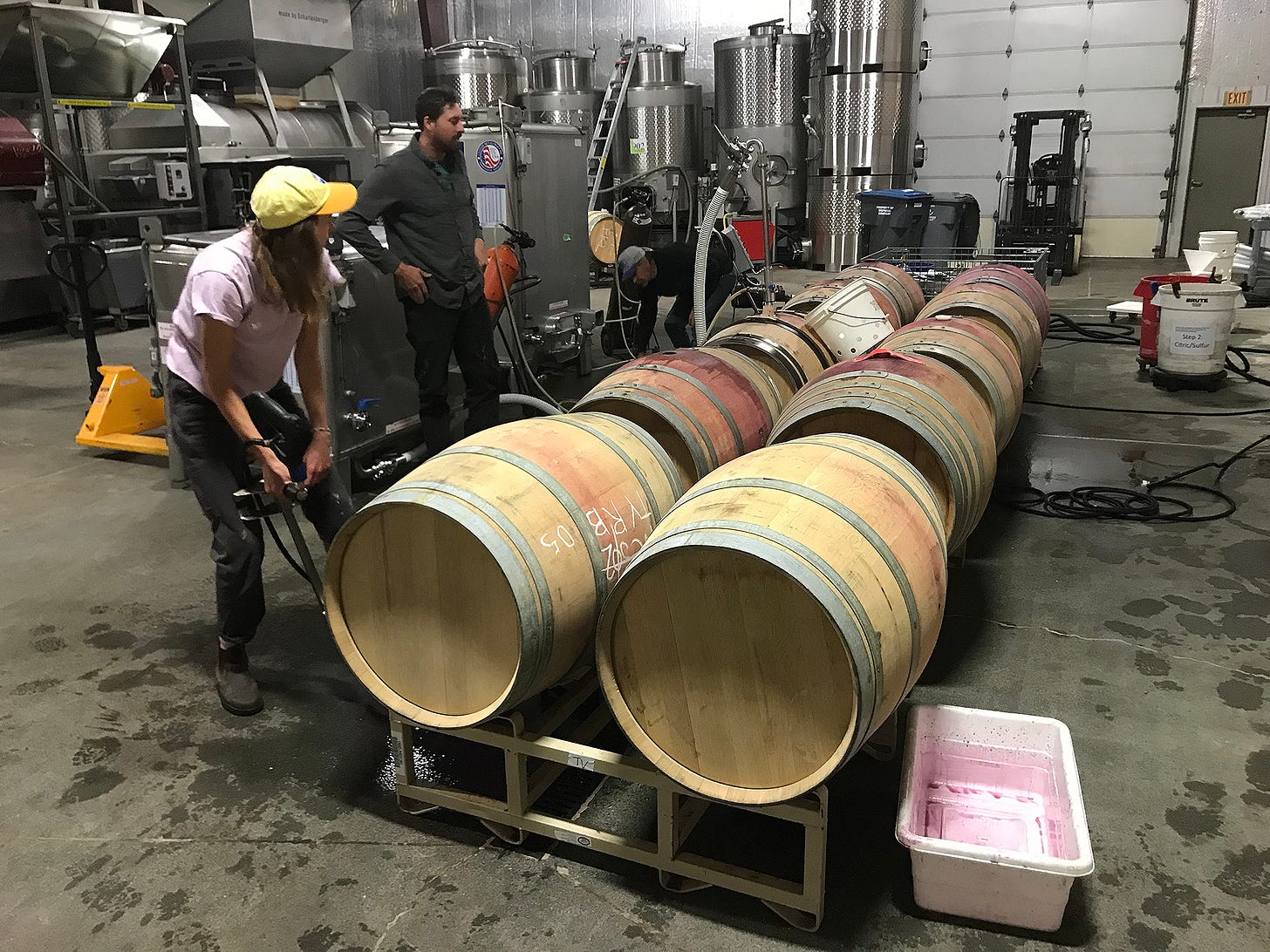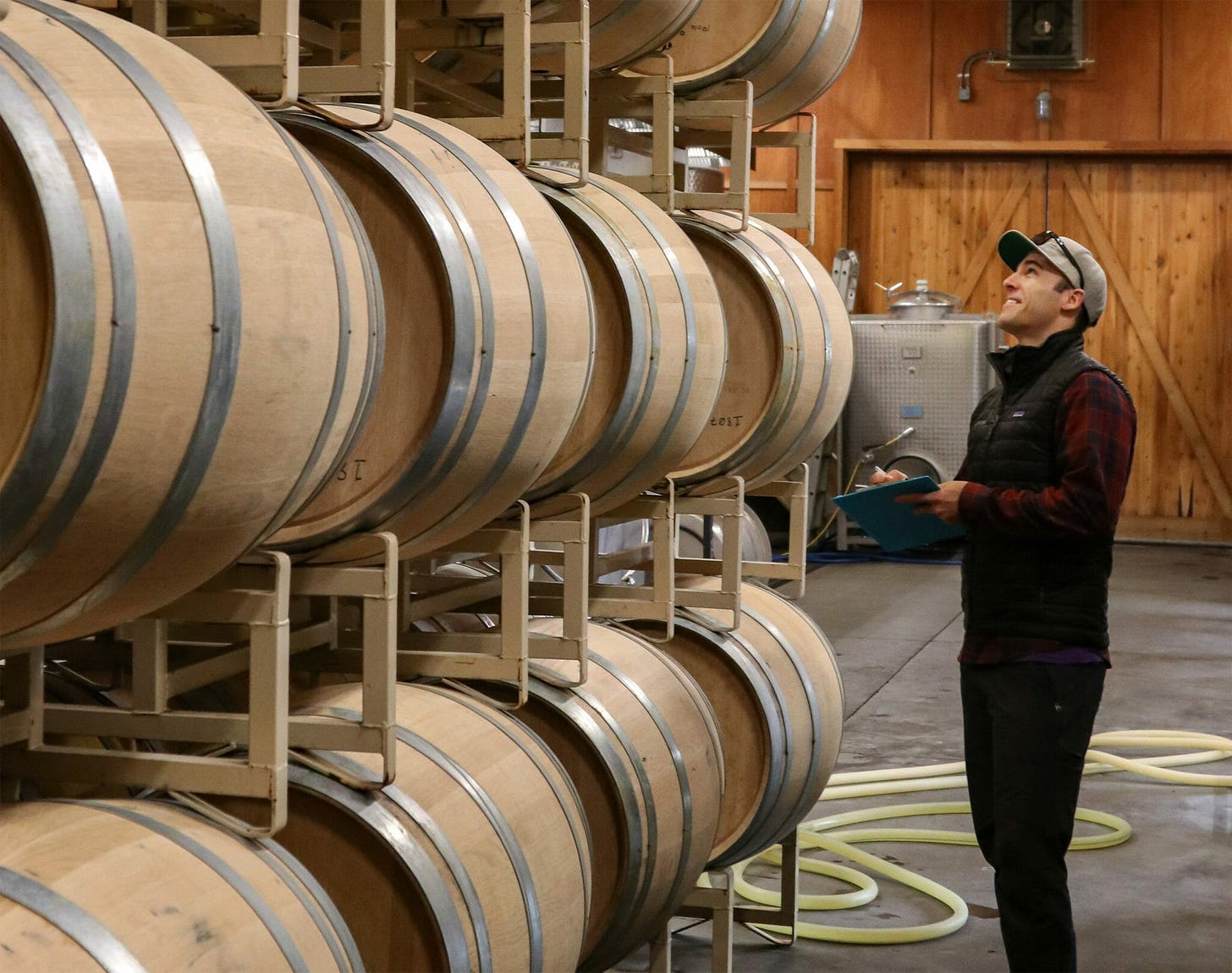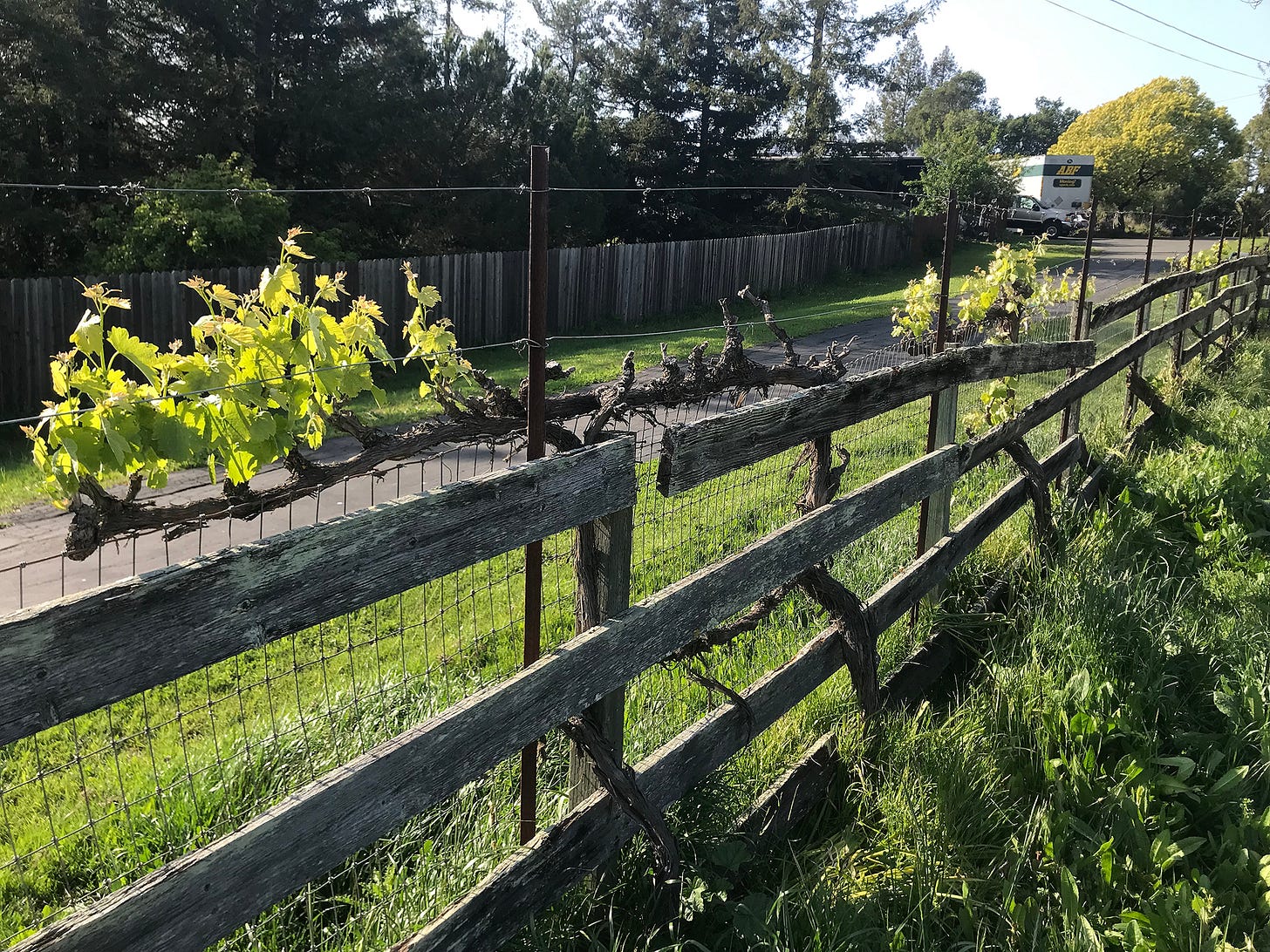It’s a little like wrestling a gorilla. You don’t quit when you’re tired – you quit when the gorilla is tired. – Robert Strauss
I’m feeling a bit overworked and under intoxicated. – Anonymous
Tempus fugit
Crikey! What happened to the last eight weeks?!
I’ll tell you what happened. Quality Control and Analysis in Winemaking happened. This course—my second to last in the U.C. Davis Winemaking Certificate Program—is busting my hump and making everything decidedly unfun in my world of professional winemaking education.
And racking my current nine barrels worth of wine happened, fine tuning some chemistry here and there, and returning everything into a different barrel to give all the wine exposure to the unique benefits of five different French oak cooperages.
Taking care of three vineyards happened, and they have all over-responded to a unique spring and the “fixes” I’ve bestowed on them. Despite late frosts and some seriously breezy days, everything flowered at the same time and with luck pollinated.
Debating about, anguishing over, finally deciding on, and then securing (following a flurry of last-minute negotiations) a rather ambitious 2022 harvest goal of just the right grapes happened—in what felt like a seller’s market for the first time in a few years.
Realizing that this increased volume of grapes is going to require finding that many more quality, once-used, French oak barrels—when the demand for barrels has also skyrocketed—also happened.
Being invited to present an hour-and-fifteen-minutes-long seminar on “Lessons Learned from Tiny Vineyards and Going Pro” at the 2022 Winemaking Magazine annual Conference THIS WEEK in San Luis Obispo happened. Yeah, maybe I went a little overboard. But it takes a lot of material to fill 75 minutes!
So I sincerely apologize for not showing up here more frequently this spring. I wasn’t playing hooky, I was treading water.
Let me elaborate…
Chemistry conundrum
I mentioned in my last post that I had a sinking feeling that my next Winemaking Certificate Program course was going to turn up the Bunsen burner and titrate a bit of cerebral whoop-ass on me. Well, it didn’t disappoint.
As with several of the courses in the program, I’ve developed a love/hate relationship with this one. There’s an ongoing challenge of learning what we need to know to become capable winemakers and discovering what we might want to know further in order to truly understand the craft. It’s a tussle between curiosity and commitment.
For instance, this Quality Control and Analysis in Winemaking gives us a broad overview of the chemistry of juice, must and wine composition including carbohydrates, acids, bases and buffers. It dives deep into the use and effect of sulfur dioxide, introduces the microbiology of yeasts and bacteria, and breaks down the chemical processes of alcoholic fermentation, malolactic fermentation and microbial spoilage. It explores the creation and preservation of wine color and phenolic compounds, the contribution of oak extractives, and the best practices for bottling and quality control. All of this it does with a healthy dose of chemical theory and analysis, and yes, dreaded calculations.
The reality is that most winemakers will simply send samples out to the lab for analysis. Beyond the obvious value of knowing what is going on when something is going on, the lab does most of the work and interpretation for you. I’m guessing few winemakers actually do in-lab chemical analysis on their own. This disconnect shows up in our course further in a series of admittedly well-produced, and even humorous at times, videos of these analyses performed by a real, live chemist. Watching them had me wanting to try doing them myself—a previously available hands-on classroom experience that I’m sure was derailed by the pandemic.
So how deep you need to go versus how deep you want to go governs the number of hours you put into studying every day. That—and a weekly quiz, three in-depth problem sets, and a comprehensive (aaauuugh!) final coming up in mid-June—pretty much have me by the short hairs right now.
Rack and switch
The most common procedure that winemakers utilize to help clarify their wine and protect it from spoilage is referred to as a “rack and return” where you drain your wine from a barrel, wash the barrel of lees and sediment, and then return the wine to the same barrel. It’s a pretty quick and efficient exercise—particularly when you have access to quality tanks, pumps, cleaning sprayers, and an experienced crew—and it is often carried out on a quarterly basis throughout the barrel aging of a wine.

On May 4th I did the second racking of my 2021 vintage wines at Magnolia and everything was tasting pretty damn good. Thus inspired, I changed it up a little by racking all the barrels of my wine of the same blend or varietal into a tank and mixing it all together to blend the subtle differences in oak extraction that the different barrels of different French oak cooperages contributed. I then cleaned out all the barrels and returned the wine. This effectively mingled the classic—and dare I say romantic!—oak notes of Sylvain, Flyer de Quintessence, Tremeaux and St. Martin.
Hands in the dirt
The vineyard work over the past two months has been the most demanding, as everything made it through bud break successfully and then didn’t look back. I laid down the cordon arms in Bobbie’s Malbec vineyard back in mid-February and I was hoping that it might help tamp down the vine’s vigor a little, but nooooo! The vines are simply out of control right now. I don’t want to mess with them too much until they finish berry set—there are hundreds of clusters!—but then this mighty little vineyard that roared is going to get a haircut.

Hassan’s vineyard had the most radical work done on it this spring as we tore out nearly a hundred dead and dying vines and excavated their old root systems, leaving holes the size of an upright 30-gallon barrel. These were backfilled with good dirt and prepared to receive SuperNova vines—three-feet tall green bench graft where the trunk of the vine is all rootstock and the graft to scion occurs at the top. This gains you a year in the vineyard, doesn’t require a plant protector, and visually fills in the space of where the old vine was. It’s a great grafting innovation and has become known throughout the industry as an “uber-vine.”

My third vineyard project this year, and undoubtedly my most unique to date, is trying to preserve and restore the 20-year-old Grenache and Syrah vines that came with a rehab property up on Bennett Valley Road. The property was recently purchased and is now being fully renovated by its two young owners Amit and Preeti. The vines had originally been planted alongside a wooden fence that circled the entire property. There are a bunch of good folks involved with this project, which includes carefully tearing out the old fence without damaging the 80 or so existing vines, building a new deer-proof fence and trellis system for the vines, and planting about a hundred new vines to fill in those that have been lost over the years.

Like I’ve said before, I think I have latent farmer in my blood. I love the complex but simple nature of growing things, and the resulting ethos of dirt and tradition that forms on your clothes, your skin, your hair, and your soul the longer you stay afield. Making wine is the legacy of growing grapes, one obviously begets the other. I can’t imagine a winemaker who isn’t a viticulturist. Perhaps that’s how we should define the position.
Gettin’ down to bidness
Back in mid-February my partner in the Tiny Vineyards Wine Company (TVWC), Bruce Flynn, flew out to Sonoma from Colorado to help with winter pruning. It was there we amped up in earnest a philosophical conversation about what TVWC should be, what it could become, and what should be the parameters of its 2022 vintage.
We knew it had to be, above all else, an expression of the best grapes from the most exclusive tiny vineyards we could find. “Tiny” being described as anything from a backyard cultivation to a few acres in size, a smaller defined lot within a larger vineyard, or even a single row from an even bigger vineyard that stood out in its quality and uniqueness. Beyond that, things were less clear and the conversation quickly became circular as we struggled with the three 800 pound gorillas that had stuffed themselves into the room:
1.) What kind of wine should we make?
2.) What style of wine should we make?
3.) How MUCH wine should we make?
We figured the first two might be easier to figure out if we could just resolve the third. Last year—my first commercial vintage—I purchased four tons of grapes, which will result in 200 cases of wine. Should we make that much again for our second vintage? Less? More? Way more?
When you make your first vintage of wine that you plan to sell you are understandably conservative, so you probably lowball it, which I did. The challenge arises with your second vintage which has to be decided upon, purchased, picked and paid for before your first vintage is even bottled. The problem continues through your third vintage, which also has to be decided on and processed before you have any real sales data from vintage number one. So, all the romance aside, starting a wine company is a dicey three-year leap of faith!

You could simply make the same low volume each year and suffer the damaging supply-and-demand fallout if folks actually like your wine. If they don’t, well, you haven’t yet extended yourself too badly. Or you can commit to what you’re doing, have faith in your wine and in yourself, and plan for healthy growth—which is the logical if not necessarily sane answer to the question oft poised by my wine guru friend Ken Wornick, “Are you in the wine business, or not?”
So I flew out to Colorado in April and continued my conversation with Bruce pretty much through to conclusion. I’ll get into all the nuance and detail in upcoming posts but suffice it to say that I was then charged with contracting for TEN tons of “the best grapes from the most exclusive tiny vineyards we could find.” I just completed that task last week.
Lookin’ for wood
Ever see that statement on a wine bottle that goes something like, “Aged six months in new oak, twelve months in neutral oak.” That’s because quality wineries will age their better wines in a smorgasbord of different cooperages and ages of oak barrels. The practice results in lots of barrels making their way through the rotation and then being sold at different ages.
A brand new 60-gallon French oak barrel will easily run you $1,200 to $1,500. The same barrel used-one-time can be purchased from a reputable winery for $150 to $200. The amount of valuable oak extraction still left in that barrel is more than enough to make the calculus here a no brainer.

Last year I secured my first seven once-used barrels for my 2021 vintage from the nicer-than-nice folks at the Spottswoode Winery in St Helena. James Revie, the assistant winemaker there, had the kindness and class to guide me through the nuances of barrel selection pretending that I understood what he was talking about. He didn’t steer me wrong either, I love those barrels!
Now that we need 22 more—yep, same problem with the first vintage not being done aging before the second vintage goes in the barrel—I’ve gone back to James. He got right back to me explaining that demand for used barrels is way up this year and he probably couldn’t supply all 22 but he’d get me what he could.
Can’t wait to drive up to Spottswoode again soon, trailer attached, and collect a load of wood. I’ll likely sneak into the barrel room there just to take a deep breath of the air inside that smells like a thick cologne of Cabernet Sauvignon and vanilla.
Who’da figured?
We’re heading out to San Luis Obispo in a couple of days where I’ll be showing my Tiny Vineyards movie on the big screen at the Palm Theatre on Thursday, June 2nd. A wine reception featuring the wines seen being made in the film will kick off at 7:00 pm, followed by the screening of the movie at 7:30 pm, followed by a Q&A with yours truly. If you’re in the area please join us!
Later in the week I’ve been invited to give a seminar at the annual Winemaker Magazine Conference, being held this year in San Luis Obispo. My talk is entitled “Lessons Learned from Tiny Vineyards & Going Pro.” and I plan to deconstruct not only the movie but this newsletter as well. Should be a hoot! That event is by registration only and is sold out. I’ll let you know how it goes.
If you’re unfamiliar with Winemaker Magazine check it out here. The publication serves amateur wine makers and viticulturists around the globe and is really quite excellent.







Excellent reporting, and we would like to me with you on our next visit to Sonoma July 6.
Lemmeno
Dominick Azzaro
914.804.2273 c
You are definitely living the dream, Joe- love how you are throwing yourself into the barrels and onto a thousand (or more) satisfied palates...